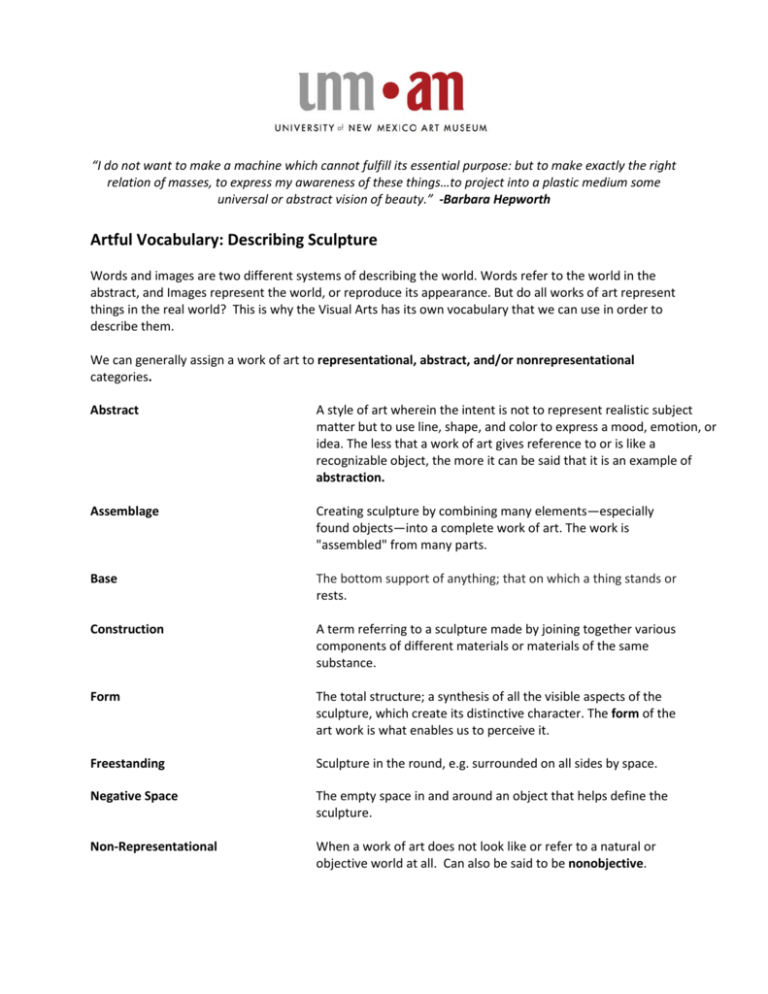Artful Vocabulary: Describing Sculpture
advertisement

“I do not want to make a machine which cannot fulfill its essential purpose: but to make exactly the right relation of masses, to express my awareness of these things…to project into a plastic medium some universal or abstract vision of beauty.” -Barbara Hepworth Artful Vocabulary: Describing Sculpture Words and images are two different systems of describing the world. Words refer to the world in the abstract, and Images represent the world, or reproduce its appearance. But do all works of art represent things in the real world? This is why the Visual Arts has its own vocabulary that we can use in order to describe them. We can generally assign a work of art to representational, abstract, and/or nonrepresentational categories. Abstract A style of art wherein the intent is not to represent realistic subject matter but to use line, shape, and color to express a mood, emotion, or idea. The less that a work of art gives reference to or is like a recognizable object, the more it can be said that it is an example of abstraction. Assemblage Creating sculpture by combining many elements—especially found objects—into a complete work of art. The work is "assembled" from many parts. Base The bottom support of anything; that on which a thing stands or rests. Construction A term referring to a sculpture made by joining together various components of different materials or materials of the same substance. Form The total structure; a synthesis of all the visible aspects of the sculpture, which create its distinctive character. The form of the art work is what enables us to perceive it. Freestanding Sculpture in the round, e.g. surrounded on all sides by space. Negative Space The empty space in and around an object that helps define the sculpture. Non-Representational When a work of art does not look like or refer to a natural or objective world at all. Can also be said to be nonobjective. Material/Medium Substance in which an artist chooses to work, ie. wood, stone, metal, wax, paper, wire, plastic, foam, or found or ready-made objects. Mass The area occupied by a form (such as a sculpture or building), in terms of bulk, density, and matter. The opposite of void. Minimalism Minimalist art is characterized by simple or reduced abstract structures and basic geometric forms—free of all reference to the figure or to nature—with few colors, lines, and textures. An art movement associated with a group of New York City artists working in the 1960s. Modeling A sculpture technique in which a three-dimensional form is manipulated in a soft material such as clay or wax. The term also refers to the effect of light on a three-dimensional form. The three-dimensional quality of such a form is emphasized by means of light, shadow, and color. Reproducing the effect of light, shadow, and color in a drawing of such a form makes it seem more realistic. An Original A work of art that implies its exclusivity, or the idea that the work is ‘one of a kind,’ rather than a copy or reproduction. Representational Portrays objects that you can recognize in their natural form; especially realistic graphic representation. The more that the image represents what our eyes see in real life, the more it can be said that the artwork is an example of realism. Sculpture A three-dimensional work of art. Such works are primarily concerned with space (occupying it, relating to it, and influencing the viewer’s perception of it); it may be carved, modeled, constructed, or cast. Sculptures can also be described as assemblage, in the round, and relief, and are made in a huge variety of media. Shape An enclosed space defined by a boundary, such as line, color, value, and texture. The two-dimensional character of shape distinguishes it from form, which has depth as well as length and width. Space Refers to the distance or area between, around, above, below, or within things. It can be described as two-dimensional or three-dimensional; as flat, shallow, or deep; as open or closed; as positive or negative; and as actual, ambiguous, or illusory. Three-dimensional Having, or appearing to have, height, width, and depth. We can say that something is three-dimensional when a work of art is either in this form (as in sculpture) or it gives the illusion of having 3 dimensions (as in a realistic or well rendered painting). Void Negative space; containing no matter. The opposite of mass.









